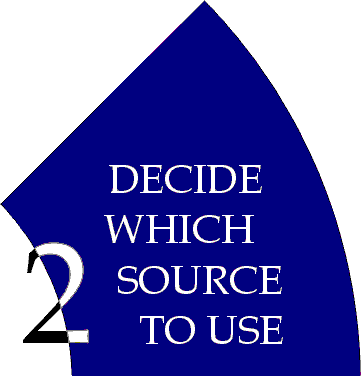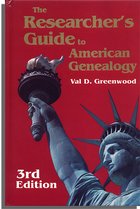SOURCES

Once you have set a goal, the next expectation is that you would know which source to use to reach that goal. The problem is, you won't know all the sources for some time yet. Therefore a chart has been developed which lists the most common sources used by genealogists (on pages 1-18 to 1-19 of The Complete Beginner's Guide. . .).
You may select some sources to help you while you are learning, but as you progress in your studies, you may find that specific sources are better at providing specific answers during certain time periods in different localities. But for now, just be patient as resources are explained to you.
 This is a good time to introduce further Val Greenwood's book, The Researcher's Guide to American Genealogy, 3rd edition.
It is suggested as supplemental reading for this course because it covers the basic sources from a legal standpoint which is very helpful. Questions for the assignments will be taken from each of your textbooks, from these genealogical presentations, and from assigned work.
One record group with which you are to become familiar with in this
course is "Vital Records." You will find that it covers a large group of differently named records that you will be able to identify in the future. Do you understand the meaning of the term? Have you noticed the
"term definitions" given in the margin of the syllabus for new terminology
you are learning this semester? For example, study the terms, "jurisdiction," "evaluation," "fact," "tradition," and "hypothesis" on page 1-4
in your textbook.
Also notice that in these online lessons, there is a glossary of words that will be learned this year and they are good to know for your exams. When you finish your lesson for this evening, click on the Home key at the bottom of the page. Look down the list of lessons to the last tab and click on "Glossary." These are the terms you will learn this semester. The chapter number in which you will learn each term in the context in which it is used is also stated in the Glossary.
Click the icon below to go to a more in-depth study on Vital Records written when your writer worked for Genealogy.com.
At the same time, that discussion will direct you to another good
genealogy computer program known as Family Tree Maker (FTM).
You might question why FTM is not recommended in this course. A bit of
history is necessary.
FTM was originally developed
by a company known as Genealogy.com. Genealogy.com and their program Family Tree Maker were
purchased by a company known as MyFamily.com. MyFamily.com now owns
both Ancestry.com and Genealogy.com. Therefore, Ancestry.com
is giving their program, Family Tree Maker, the ability to access
the enormous data bases they have purchased in an excellent manner.
The program produces lovely forms, charts, and some reports. The program
has a real handsome look and feel.
However, we do not suggest you use this program in this beginning course
for several reasons.
- You need to learn how to access original records in their original context
because someday you might be working for one of these major companies,
and they will need your knowledge to know which records are most helpful
for the tasks at hand. This genealogy course is training you to go beyond online sources which contain only a very small portion of the records needed to solve genealogy problems.
- The current version of FTM is not the best program for organizing
your paper files. Using the free version of PAF, Legacy, or Ancestral Quest is just fine and can later
be exported into FTM if you want to use it later. We need to help you become better
organized at this point.
- Many of the features in FTM are not readable in other programs, so
your instructor would not be able to properly grade your skills.
- The program costs money and usually must be upgraded yearly. Students
and colleges don't want the added expense.
Throughout your studies in these genealogy courses, however, we will keep you informed about what programs are valuable to use for what circumstances. Hopefully, you will find it satisfactory to use one of the free programs such as Personal Ancestral File (PAF) program. It has all the basic features needed for a beginner as well as a professional, it is free, and it uploads to other programs if you want to use the features of these other programs. |